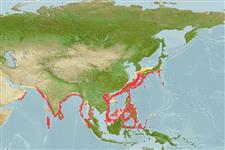Environment: milieu / climate zone / depth range / distribution range
Écologie
marin démersal; profondeur 100 - ? m (Ref. 114953). Tropical; 42°N - 0°N, 55°E - 143°E (Ref. 114953)
Indo-West Pacific; Oman (Arabian Sea) to north-east Asia (China and Japan).
Taille / Poids / Âge
Maturity: Lm ? range ? - ? cm
Max length : 18.0 cm TL mâle / non sexé; (Ref. 9913); common length : 20.0 cm TL mâle / non sexé; (Ref. 114953)
Found in continental waters, both inshore and offshore (Ref. 9913). Mainly feeds on crustaceans and polychaetes (Ref. 114953). Biology little known (Ref. 9913) but reported to produce 4-6 young each gestation (Ref. 114953). Adult males and females known at 15 cm TL; common size reported to reach 35 cm TL (Ref. 114953). The electric organs present on disc are used to stun the prey.
Life cycle and mating behavior
Maturities | Reproduction | Spawnings | Egg(s) | Fecundities | Larves
Compagno, L.J.V. and P.R. Last, 1999. Narkidae. Sleeper rays. p. 1443-1446. In K.E. Carpenter and V.H. Niem (eds.) FAO identification guide for fishery purposes. The living marine resources of the Western Central Pacific. FAO, Rome. (Ref. 9913)
Statut dans la liste rouge de l'IUCN (Ref. 130435)
Utilisations par l'homme
Pêcheries: intérêt commercial mineur
Outils
Articles particuliers
Télécharger en XML
Sources Internet
Estimates based on models
Preferred temperature (Ref.
123201): 19 - 28.2, mean 26.4 °C (based on 992 cells).
Phylogenetic diversity index (Ref.
82804): PD
50 = 0.6252 [Uniqueness, from 0.5 = low to 2.0 = high].
Bayesian length-weight: a=0.01000 (0.00244 - 0.04107), b=3.04 (2.81 - 3.27), in cm total length, based on all LWR estimates for this body shape (Ref.
93245).
Niveau trophique (Ref.
69278): 3.2 ±0.3 se; based on size and trophs of closest relatives
Résilience (Ref.
120179): Faible, temps minimum de doublement de population : 4,5 à 14 années (Assuming fecundity<100).
Fishing Vulnerability (Ref.
59153): Low vulnerability (10 of 100).
